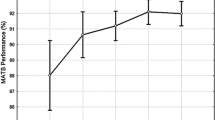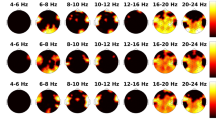Abstract
The goal of this paper was to assess the impact of learning a new skill on several electroencephalographic (EEG) measurements. In addition, it intended to examine the active brain regions associated with learning. To this effect, changes in brain activity during the pre- and post-learning task were investigated using EEG power spectral density (PSD) and nonlinear features. The evaluated task was learning to type using the Colemak keyboard layout in a twelve-lesson training. 10 participants with a mean age of 29.3 ± 5.7 were included in the experiment. For the first time, Fractal dimension, approximate entropy, and Lyapunov exponents were extracted from a 9-channel EEG signal to characterize brain dynamics. In addition, the PSD of various EEG rhythms was estimated. To identify statistically significant changes in the EEG characteristics, as well as to determine the prominent channels, the t-test was performed. Our results showed maximum EEG power in Beta and Gamma waves; however, the most differences in the power distribution belonged to the Beta band. Among nonlinear features, entropy showed a significant difference in 70% of the EEG channels. This has mainly occurred in the F3, Fz, C3, Cz, POz, and P4 electrodes. Taken together, the results of this study pave the way to evaluate brain dynamics and actively involved areas in pre- and post-learning tasks.











Similar content being viewed by others
References
Duch, W.: Brains and education: towards neurocognitive phenomics. In: Reynolds, N., Webb, M., Sysło, M.M., Dagiene, V. (eds.) Learning While We are Connected, vol. 3, pp. 12–23. Citeseer (2013)
Rioult-Pedotti, M., Friedman, D., Donoghue, J.: Learning-induced LTP in neocortex. Science 290, 533–536 (2000)
Amin, H.U., Malik, A.S., Badruddin, N., Chooi, W.T.: Brain behavior in learning and memory recall process: a high resolution EEG analysis. In: The 15th International Conference on Biomedical Engineering. IFMBE Proceedings, vol. 43 (2014)
Henz, D., John, A., Merz, C., Schöllhorn, W.I.: Post-task effects on EEG brain activity differ for various differential learning and contextual interference protocols. Front. Hum. Neurosci. 12, 19 (2018)
Miraglia, F., Vecchio, F., Rossini, P.M.: Brain electroencephalographic segregation as a biomarker of learning. Neural Netw. 106, 168–174 (2018)
Kaiser, J., Belenya, R., Chung, W.Y., Gentsch, A., Schütz-Bosbach, S.: Learning something new versus changing your ways: distinct effects on midfrontal oscillations and cardiac activity for learning and flexible adjustments. Neuroimage 226, 117550 (2021)
Thompson, L.W., Obrist, W.D.: EEG correlates of verbal learning and overlearning. Electroencephalogr. Clin. Neurophysiol. 16, 332–342 (1964)
Jawed, S., Amin, H.U., Malik, A.S., Faye, I.: Classification of visual and non-visual learners using electroencephalographic alpha and gamma activities. Front. Behav. Neurosci. 13, 86 (2019)
Lehnertz, K.: Nonlinear approaches to learning and memory. In: Proceedings of the 1st International IEEE EMBS Conference on Neural Engineering (2003)
Osterhout, L., Poliakov, A., Inoue, K., McLaughlin, J., Valentine, G., Pitkanen, I., et al.: Second-language learning and changes in the brain. J. Neurolinguist. 21(6), 509–521 (2008)
Ciechanski, P., Cheng, A., Damji, O., Lopushinsky, S., Hecker, K., Jadavji, Z., et al.: Effects of transcranial direct-current stimulation on neurosurgical skill acquisition. BJS Open 2, 70–78 (2018)
Ciechanski, P., Kirton, A., Wilson, B., Williams, C.C., Anderson, S.J., Cheng, A., et al.: Electroencephalography correlates of transcranial direct-current stimulation enhanced surgical skill learning: a replication and extension study. Brain Res. 1725, 146445 (2019)
Ciechanski, P., Cheng, A., Lopushinsky, S., Hecker, K., Gan, L.S., Lang, S., et al.: Effects of transcranial direct-current stimulation on neurosurgical skill acquisition: a randomized controlled trial. World Neurosurg. 108, 876–884 (2017)
Arab, M.R., Nadjafi, M., Khosrowabadi, R., Setoudeh, F., Avakoli, M.B.: Organization the memory processes in the brain based on fractal analysis. Adv. Cogn. Sci. 23(1), 128–139 (2021)
Gutierrez, D., Ramirez-Moreno, M.A.: Assessing a learning process with functional ANOVA estimators of EEG power spectral densities. Cogn. Neurodyn. 10, 175–183 (2015)
Mohammadi, M.R., Khaleghi, A., Moti Nasrabadi, A., Rafieivand, S., Begol, M., Zarafshan, H.: EEG classification of ADHD and normal children using non-linear features and neural network. Biomed. Eng. Lett. 6, 66–73 (2016)
Katz, M.J.: Fractals and the analysis of waveforms. Comput. Boil. Med. 18(3), 145–156 (1988)
Petrosian, A.: Kolmogorov complexity of finite sequences and recognition of different preictal EEG patterns. In: Proceedings Eighth IEEE Symposium on Computer-Based Medical Systems, pp. 212–217 (1995)
Acharya, U.R., Vinitha Sree, S., Swapna, G., Martis, R.J., Suri, J.S.: Automated EEG analysis of epilepsy: a review. Knowl Based Syst 45, 147–165 (2013)
Principe, J., Lo, P.: Towards the determination of the largest Lyapunov exponent of EEG segments. In: Proceedings of the Conference on Measuring Chaos in the Human Brain. World Scientific, Singapore, pp. 156–166 (1991)
Röschke, J., Fell, J., Beckmann, P.: The calculation of the first positive Lyapunov exponent in sleep EEG data. Electroencephalogr. Clin. Neurophysiol. 86(5), 348–352 (1993)
Gutierrez, D., Member, S., IEEE, Ramirez-Moreno, M.A., Lazcano-Herrera, A.G.: Assessing the acquisition of a new skill with electroencephalography. In: 7th Annual International IEEE EMBS Conference on Neural Engineering (2015)
Aliakbaryhosseinabadi, S., Lontis, R., Farina, D., Mrachacz-Kersting, N.: Effect of motor learning with different complexities on EEG spectral distribution and performance improvement. Biomed. Signal Process. Control 66, 102447 (2021)
Niemann, J., Winker, T., Gerling, J., Landwehrmeyer, B., Jung, R.: Changes of slow cortical negative dc potentials during the acquisition of a complex finger motor task. Exp. Brain Res. 85(2), 417–422 (1991)
Vecchio, F., Miraglia, F., Curcio, G., Altavilla, R., Scrascia, F., Giambattistelli, F., Quattrocchi, C.C., Bramanti, P., Vernieri, F., Rossini, P.M.: Cortical brain connectivity evaluated by graph theory in dementia: a correlation study 748 between functional and structural data. J. Alzheimers Dis. 45, 749 (2015)
PourAfrouz, E., Setayeshi, S., Allah Bigdeli, I., Pedram, M.M.: Brain wave analysis of mindfulness training in healthy people. Shefaye Khatam 9(1), 11–26 (2020)
Funding
This research did not receive any specific Grant from funding agencies in the public, commercial, or not-for-profit sectors.
Author information
Authors and Affiliations
Contributions
F.J. and A.G. wrote the main manuscript text and analyzed and interpreted the data. A.G. performed critical revision of the manuscript for important intellectual content. F.J. prepared figures. All authors reviewed the final version of the manuscript.
Corresponding author
Ethics declarations
Conflict of interest
The authors declare that they have no conflict of interest.
Ethical approval
This article does not contain any studies with human participants performed by any of the authors.
Additional information
Publisher's Note
Springer Nature remains neutral with regard to jurisdictional claims in published maps and institutional affiliations.
Rights and permissions
Springer Nature or its licensor holds exclusive rights to this article under a publishing agreement with the author(s) or other rightsholder(s); author self-archiving of the accepted manuscript version of this article is solely governed by the terms of such publishing agreement and applicable law.
About this article
Cite this article
Jalaly, F., Goshvarpour, A. Assessment of learning a new skill using nonlinear and spectral features of EEG. SIViP 17, 1199–1207 (2023). https://doi.org/10.1007/s11760-022-02327-8
Received:
Revised:
Accepted:
Published:
Issue Date:
DOI: https://doi.org/10.1007/s11760-022-02327-8




